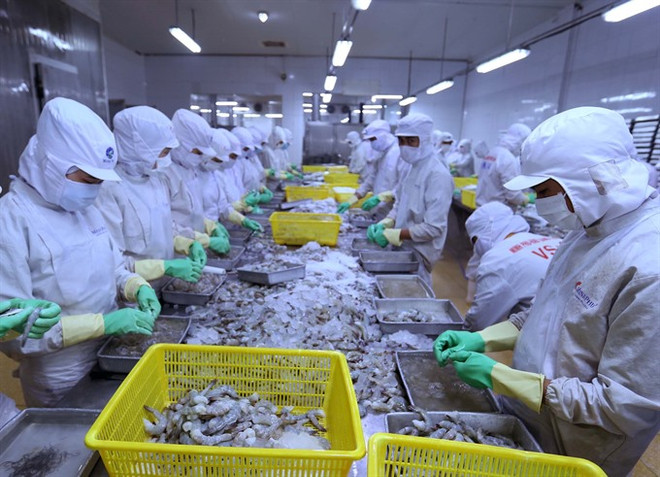To thatend, it will work to increase the total aquaculture production by 3.6 percentto 4.3 million tonnes, including 1.4 million tonnes of tra fish and 852,000tonnes of shrimp of all kinds, up 3 percent and 6.5 percent, respectively.
It will also strive to catch 3.68 milliontonnes, up 2.5 percent year-on-year.
The sector will effectively carry out thenational action plan on shrimp development by 2025, the master plan on thedevelopment of the shrimp industry by 2025, and the three-tier cooperation planfor the production of high-quality tra fish breeds in the Mekong Delta until2025.
Inspections will be intensified to control thequality of feed and products improving the farming environment, prevent the useof banned antibiotics, and antibiotic abuse in aquatic farming.
More inspection teams will also be organizedto supervise the implementation of regulations related to the management anduse of fishing vessels at localities, and the granting of registration licensesto ship owners.
Speaking at a conference todiscuss export plans in HCM City on February 16, VASEP Chairman Ngo Van Ichsaid Vietnam’s seafood exports last year had been worth 9 billion USD, ayear-on year increase of 6 percent, and met the target.
Of which, Tra fish exports had surged 26 percent to 2.26 billion USDthanks to increased buying by the US and China and the recovery of the EUmarket, he said.
But shrimp exports were down 8 percent to 3.6 billion USD due to a drop indemand in a number of markets such as the US and Canada and higher productionby competitors like India, Indonesia and Thailand, resulting in a 15-20 percentfall in prices, he added.
Ich said last year had also been difficult for the industry after the ECimposed a yellow card warning on Vietnamese seafood for failing to makeprogress in fighting illegal, unreported and unregulated (IUU) fishing.
But things would look up this year, he noted.
“Exports increased by just 6 percent last year, rather low considering thesector’s capacity. The sector can absolutely achieve growth of 10 percent andeven 12 percent a year if it is developed in the right direction.”
With its potential and preferential tariffs from free trade agreements,including the Comprehensive and Progressive Agreement for Trans-PacificPartnership, the sector would achieve an export turnover of 10 billion USD thisyear, he said.
“In 2019, shrimp exports are expected to be better because the US Department ofCommerce recently announced the final results of the 12th period of review (POR12), lowering the anti-dumping tariff on shrimp imports from Vietnam.”
Truong Dinh Hoe, VASEP General Secretary, said the export of shrimp, tra fishand other seafood products was expected to reach 4.2 billion USD, 2.3 billionUSD and 3.5 billion USD this year.
The sector would also work to get the EC yellow card warning lifted this year,he said.
But the many positivesignals notwithstanding, the sector also faces many challenges in terms of rawmaterials, competitiveness and market barriers.
“Actively sourcing raw materials is always an advantage to businesses, but thisis not being done well.”
Climate change, saltwater intrusion in rivers and diseases are some of thereasons causing a shortage of raw materials while the anti-dumping duty imposedby the US and its Seafood Import Monitoring Programme have also createdpressure on businesses, according to Hoe.
Raw shrimp prices are higher than in other countries in the region and otherinput costs have also increased, affecting Vietnam’s competiveness.
Ich and Hoe agreed that to achieve the targets the sector would need a specificdevelopment strategy with a focus on preventing shrimp diseases, stopping theuse of chemicals in aquaculture, capitalising on preferential tariffs under theVietnam-EU FTA, which takes effect this year, to boost exports to the EU, andimporting legal seafood materials for processing for export.
Minister of Agriculture and Rural Development Nguyen Xuan Cuong hailed theexport efforts last year, but said the target of 10 billion USD for this yearwould be very high despite having a firm foundation to achieve it.
Shrimp exports were looking up, tra fish was popular in many markets andseafood exploitation was gradually becoming sustainable.
To accomplish the export target, stakeholders in the fisheries value chain fromthe exploitation and processing stages to distribution and exports needed tofurther enhance cooperation and improve the management at each stage.
The exploitation and production of raw materials had to follow clean processesand comply with input quality standards while the processing phase had toimprove technology and management to reduce production costs.
Besides sustaining traditional markets, companies and business groups had tofind new markets but also exploit the lucrative domestic market of nearly 100million people and 15 million international visitors annually.-VNA





























